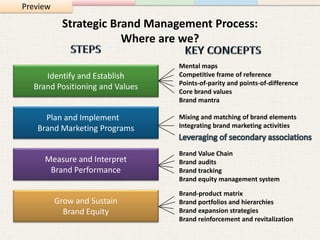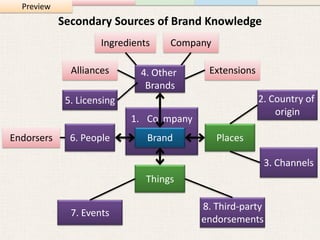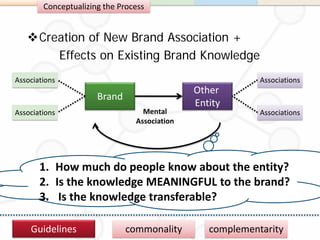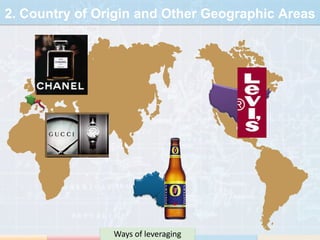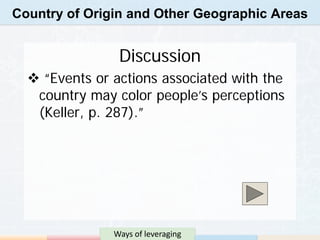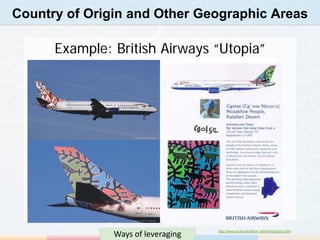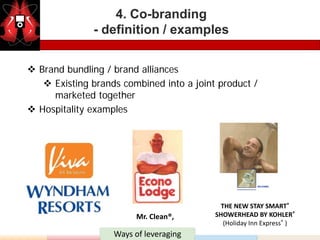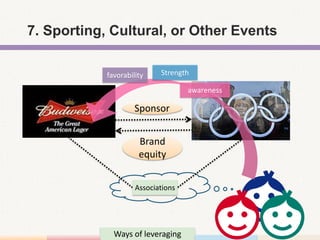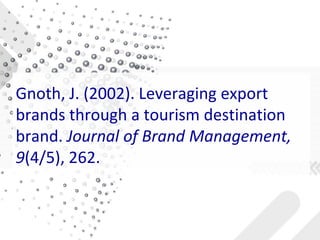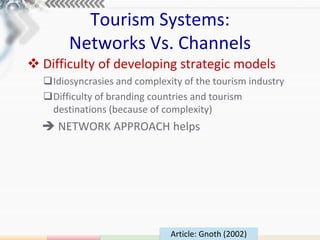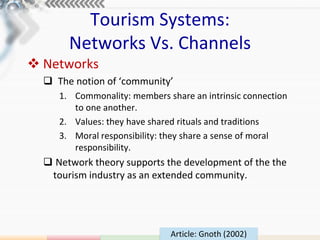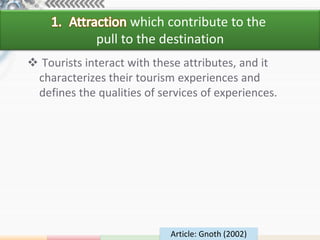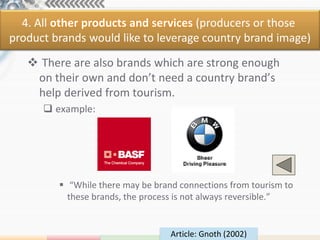Strategic Brand Management: Building, Measuring, and Managing Brand Equity (3rd ed.) Chapter 7 (Leveraging Secondary Brand Associations to Build Brand Equity)
- 1. HTM 631 (Spring 2009) Keller, K. L. (2008). Strategic Brand Management: Building, Measuring, and Managing Brand Equity (3rd ed.), Prentice Hall. 7. Leveraging Secondary Brand Associations to Build Brand Equity Suh-hee Choi
- 2. Preview Strategic Brand Management Process: Where are we? Mental maps Identify and Establish Competitive frame of reference Points-of-parity and points-of-difference Brand Positioning and Values Core brand values Brand mantra Plan and Implement Mixing and matching of brand elements Brand Marketing Programs Integrating brand marketing activities Brand Value Chain Measure and Interpret Brand audits Brand Performance Brand tracking Brand equity management system Brand-product matrix Grow and Sustain Brand portfolios and hierarchies Brand Equity Brand expansion strategies Brand reinforcement and revitalization
- 3. Preview Secondary Sources of Brand Knowledge Ingredients Company Alliances 4. Other Extensions Brands 5. Licensing 2. Country of origin 1. Co mpany Endorsers 6. People Brand Places 3. Channels Things 8. Third-party 7. Events endorsements
- 4. Conceptualizing the Process Creation of New Brand Association + Effects on Existing Brand Knowledge Associations Associations Other Brand Entity Associations Mental Associations Association 1. How much do people know about the entity? 2. Is the knowledge MEANINGFUL to the brand? 3. Is the knowledge transferable? Guidelines commonality complementarity
- 5. Conceptualizing the Process Discussion Let’s think of the example of successful “cause marketing programs” (p. 282) in hospitality and tourism industry. How do they enhance brand image, feelings, attitudes, and experiences?
- 6. 1. Company (Branding Strategies) 1. Creating a new brand 2. Adopting / modifying an existing brand 3. Combining brands Ways of leveraging
- 7. 2. Country of Origin and Other Geographic Areas Ways of leveraging
- 8. Country of Origin and Other Geographic Areas Ways of leveraging
- 9. Country of Origin and Other Geographic Areas Discussion “Events or actions associated with the country may color people’s perceptions (Keller, p. 287).” Ways of leveraging
- 10. Country of Origin and Other Geographic Areas Example: British Airways “Utopia” Ways of leveraging http://www.lockonaviation.net/html/utopia.html
- 11. Country of Origin and Other Geographic Areas Example: (p. 288) • In 2003, Wedgwood closed two factories and move factories to Asia. • Research in the U.S. showed that what customers wanted was the Waterford label and not where the crystal was made. • Retailers worried that it could harm its brand image. http://www.youtube.com/watch?v=WP9RmuoZUpg Ways of leveraging
- 12. 3.Channels of Distribution http://www.careernomics.com/Loreal0709/ca Ways of leveraging n/excelling.php
- 13. 4. Co-branding - definition / examples Brand bundling / brand alliances Existing brands combined into a joint product / marketed together Hospitality examples THE NEW STAY SMART® Mr. Clean®, SHOWERHEAD BY KOHLER® (Holiday Inn Express® ) Ways of leveraging
- 14. Co-branding - advantages/disadvantages Advantages Disadvantages 1. Borrow needed 1. Loss of control expertise 2. Risk of brand equity 2. Leverage equity you dilution don’t have 3. Negative feedback 3. Reduce cost of product effects introduction 4. Lack of brand focus and 4. Expand brand meaning clarity into related categories 5. Organizational 5. Source of additional distraction revenue Ways of leveraging
- 15. Co-branding -guidelines Guidelines - Each brand should have adequate brand awareness + judgment + feelings. - Marketers should ask: • our capabilities • resource constraints (people, time, money) • our goals - Marketers should check: • profitability • contribution to brand equity • extrinsic advantages Ways of leveraging
- 16. Co-branding -ingredient branding A special case of co-branding which creates brand equity for materials, components, or parts that are necessarily contained within other branded products. Benefits - Consumers: a signal of quality + reduce risk - Host product producers : leverage the equity from the ingredient brand to enhance its own brand equity Disadvantages : loss of control, consumer confusion Hospitality and tourism examples: - Tourism package with …….. ? Ways of leveraging
- 17. 5. Licensing Contractual agreement to use names, logos, characters, etc. Entertainment licensing : characters from movies/cartoons Lucrative for licensors Guidelines : beware of short-lived brands! Corporate trademark licensing - licensing a company’s names, logos, and brands to be used in various products. - advantage : increase brand exposure, generate extra revenues, enhance brand image - disadvantage : inappropriate licensing harm the brand reputation Ways of leveraging
- 18. Licensing Hospitality industry examples? http://www.nick.com http://www.nickhotel.com Ways of leveraging
- 19. Licensing Tourism industry examples? http://www.tourism.australia.com/Marketing.asp?sub=0413& al=2119 Ways of leveraging
- 20. 6. People: Celebrity Endorsement "What do I wear in bed? Why, Chanel No.5, of course." Using well-known and admired people : Consumers judge based on the knowledge about the celebrities. - Advantage : easier to draw attention to a brand. - Potential problems • when celebrity endorse too many products.... • when the celebrity’s image and brand image doesn’t match…. • when people think the celebrities endorse just for the money - Strategic evaluation / selection of celebrity required Ways of leveraging
- 21. Celebrity Endorsement Example December 11, 2008 02:10:41 GMT “Chris Brown's "Got Milk?" print ad has hit the Internet…” February 11, 2009 02:49:48 GMT “Having his "Got Milk?" ad campaign coming to an end this week, Chris Brown will no longer be used as the celebrity face of the project.” “The dropping of Chris Brown by several companies, which products he endorses, adds fuel to the existing speculation that his felony battery case can ruin not only his reputation, but also his career. Still, there have yet comments issued by the star himself or his people.” Ways of leveraging
- 22. 7. Sporting, Cultural, or Other Events favorability Strength awareness Sponsor Brand equity Associations Ways of leveraging
- 23. 8. Third-party Sources Brand Third-party endorser Hospitality and Tourism industry examples? Ways of leveraging http://www.dinegreen.com/
- 24. Gnoth, J. (2002). Leveraging export brands through a tourism destination brand. Journal of Brand Management, 9(4/5), 262.
- 25. Creates Leverage Country as a tourism destination brand Products and services in export market Article: Gnoth (2002)
- 26. Tourism Systems: Networks Vs. Channels Tourism product Attraction Transport Accommodation Hospitality Article: Gnoth (2002)
- 27. Tourism Systems: Networks Vs. Channels Difficulty of developing strategic models Idiosyncrasies and complexity of the tourism industry Difficulty of branding countries and tourism destinations (because of complexity) NETWORK APPROACH helps Article: Gnoth (2002)
- 28. Tourism Systems: Networks Vs. Channels Networks The notion of ‘community’ 1. Commonality: members share an intrinsic connection to one another. 2. Values: they have shared rituals and traditions 3. Moral responsibility: they share a sense of moral responsibility. Network theory supports the development of the the tourism industry as an extended community. Article: Gnoth (2002)
- 29. Extension of the tourism brand to other products and services which contribute to the pull to the destination Branding the essential tourism service which facilitate the tourism experience Brand extension to non-tourism and export industries Brand extension to other products and service (producers or those product brands would like to leverage country brand image) Article: Gnoth (2002)
- 30. which contribute to the pull to the destination Tourists interact with these attributes, and it characterizes their tourism experiences and defines the qualities of services of experiences. Article: Gnoth (2002)
- 31. 2. Branding the essential tourism service which facilitate the tourism experience Intangibles allows a company, region, or country to provide unique service delivery. Branding the services facilitating the attraction the second level of brand extension. Article: Gnoth (2002)
- 32. 3. Brand extension to supporting infrastructure, non-tourism, and export industries Food grown in the country Technological products (e.g. skis) Socio-political infrastructure (reputational capital) --------------------------------------------------------------------- Strategies to select important attributes are important. Article: Gnoth (2002)
- 33. 4. All other products and services (producers or those product brands would like to leverage country brand image) There are also brands which are strong enough on their own and don’t need a country brand’s help derived from tourism. example: “While there may be brand connections from tourism to these brands, the process is not always reversible.” Article: Gnoth (2002)
- 34. The emergence and role of a country as a brand Again, network is important! When tourists experience cohesive attributes within a contiguous network throughout the country, new information is interpreted in a way that has been organized through past destination (country) brand experiences. Article: Gnoth (2002)
- 35. Gnoth (2002) : Discussion Isn’t is necessary in some cases that export brands need to be disjoined from tourism destination brand? Some researchers argue that three levels of experiences (functional, experiential, and symbolic level) are not accumulative while others don’t. What do you think? Isn’t it possible that “unifying” the brand image limits the scope of destination images and eventually narrows down the target market? “While there may be brand connections from tourism to corporate brands, the process is not always reversible.” What do you think of this statement? Article: Gnoth (2002)
- 36. Review Conclusion Gnoth (2002) Managing tourism systems as network + managing brand attributes are important. Keller, Ch. 7 Customers expect that there are same attributes between the source factors and the brand. Consequently, marketers can borrow the brand equity from these source to enhance their own brand equity. 8 ways to leverage secondary associations : 1) the company 2) the country or other geographic location 3) other channel members that sell the product 4) other brands such as ingredient brands 5) licensed characters 6) endorsers 7) events 8) third-party sources Risks exist : Marketers have to sacrifice control.

